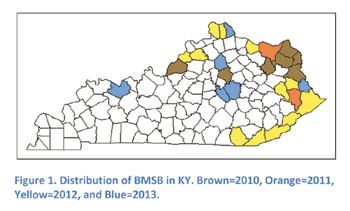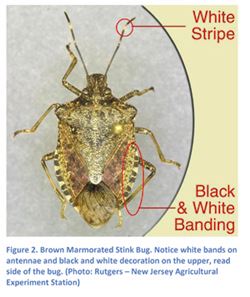Brown Marmorated Stink Bug . . . Let’s Not Forget About This One!
Dr. Doug Johnson
PRINCETON, KY.
I have just been reminded by my colleague in Lexington that brown
marmorated stink bug (BMSB) continues to move and build in numbers in
KY. BMSB was recently collected from soybeans in Fayette County KY,
still in very low numbers, but in fact they are beginning to utilize one
of our major field crops as a host/food source. If our sister state of
Virginia is any indication, we can only expect that this will get worse.
From specimen collections and those sent in for identification, we know
that BMSB has been in KY since at least 2010 probably traveling to us
down the I-64 corridor. The current known distribution in KY is shown in
Figure 1. Conversely, in our three-year (2010-12) stinkbug survey in
soybeans, we captured only two BMSB juveniles late in the season in
Carter County. Additionally, in black light trap surveys in Fayette
County (UK North Farms) and Caldwell County (UK-Research & Education
Center) no BMSB were collected in 2012 in either location and in 2013
none have been captured at either location through the time of this
writing. Given this situation BMSB will probably not be an economic
problem in field crops this year. Nonetheless, one can expect them to
become more common over the course of years.

Currently BMSBs in the Bluegrass appear to be making their move from
host plants to overwintering sites. Dr. Ric Bessin, Extension
Entomologist located in Lexington, is seeing them cluster on the sides
of buildings. This might be a good time for agricultural interests to
gauge the presence of this pest. Anyone noticing large numbers of brown
stink bugs (not orange & black or red & black bugs) congregated
on the sides of buildings is encouraged to collect some and either take
them to their local County Extension Office or send them to the UK
Entomology Dept. in Lexington or the UK Research & Education Center
in Princeton, KY for identification. If you wish to send a photograph it
is important to understand that we will need a clear, sharp picture of
the antennae and upper rear side of the bug (Figure 2). We would also
like to know when and where the bug was collected or the photo taken.
This information will help us establish any changes in distribution and
abundance of this pest in the Commonwealth.

Given the current known distribution of BMSB in KY, it appears that the
potential for infestation of grain crops will first come to eastern and
central KY. We do know from our partner Land Grant Institutions in New
Jersey, Maryland, Virginia, and Pennsylvania that this pest will infest
both corn and soybeans, and may be expected to cause considerable
trouble. In addition, BMSB will attack a large variety of fruits and
vegetables. So, field crop farmers will not be the only ones facing
problems. Commercial fruit and vegetable producers and even home
gardeners may suffer major damage from this pest.∆
DR. DOUG JOHNSON: Extension Entomologist, University of Kentucky